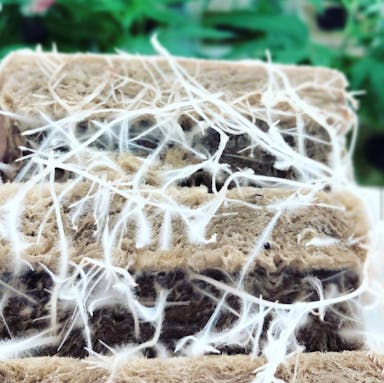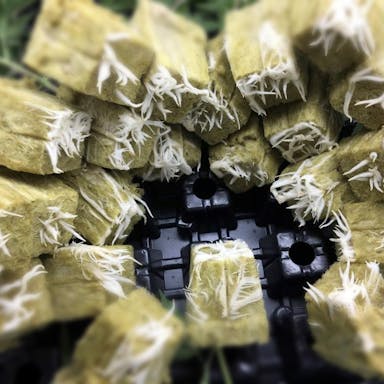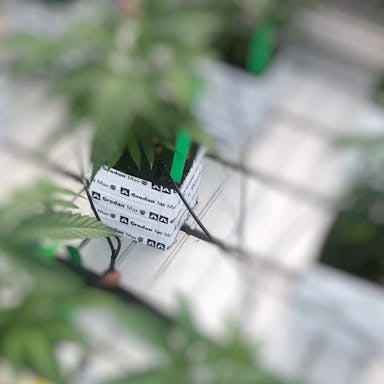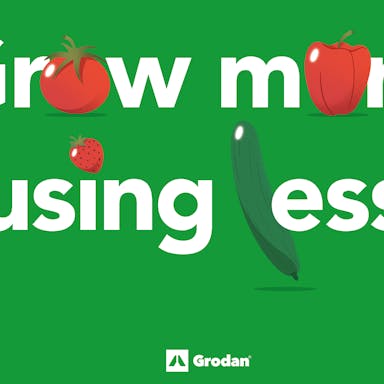“Why data-driven cultivation is relevant”
As a researcher at Wageningen University & Research and co-organiser of the Autonomous Greenhouse Challenge, Silke Hemming closely follows developments in the field of data-driven cultivation. “There are still many hurdles ahead, but the whole world is looking over our shoulder and helping us to further this form of cultivation. Fifteen years ago nobody had any faith in the initiative, but things have changed since then.”
A lot has meanwhile been said and written about the first edition of the Autonomous Greenhouse Challenge. Interest in the second edition, which will start mid-December 2019 and will be even more challenging, is overwhelming. More than a hundred teams of mixed composition (students, researchers, programmers and cultivation specialists) from all over the world registered for the exciting competition. Grodan is one of the sponsors facilitating the competition and providing the participating teams with GroSens slab sensors and substrate slabs.
Not new, but definitely innovative
Data-driven cultivation is not a new development. After all, growers have for quite some time been basing their cultivation strategies on climate data measured inside and outside their greenhouses, comparing them with past data or data obtained by other growers. So why all this sudden interest in data-driven cultivation?
“It’s all due to radical evolutions in technology enabling us to zoom in on plants and in models accurately predicting how plants will respond to setpoints. They enable us to predict the future too, and support growers in their cultivation strategies,” says Silke Hemming. “Tech companies have been working on data platforms for food for some time. The emergence of new revenue models in plant production – such as vertical farming concepts and intensive cultivation using LED light – is intensifying the need for control methods and accelerating developments in data-driven cultivation. The Challenge is a great way of gaining more knowledge and experience, testing new technology and learning from the results.”
From reactive to pro-active
At present, a crop’s development is still managed mostly on the basis of personal observations and instinct. According to the researcher, even more traditional growers are slowly coming to realise that green fingers are all very well, but not the be-all and end-all of a successful crop. “Growers still tend to control their crops’ development in a very reactive way,” continues Hemming. “By adjusting setpoints to curb vegetative or generative growth, or in response to symptoms of deficiencies. But in actual fact, your crop has been performing suboptimally for some time by that point. The sensors that are now becoming available enable you to monitor developments in real time, for example conditions in a plant’s root environment, microclimate and even its photosynthesis. And that information is precisely what you need to take action at a much earlier stage. You can combine the information with advanced growth models to prevent suboptimal performance. And the outcomes will be higher yields, better product quality, greater resistance and more efficient use of energy, CO2, water and nutrients.”
Work in progress
The researcher explains that the supply industry is already busy developing platforms to facilitate data-driven cultivation and make it available for practical use. “Your e-Gro concept is a good example of this,” she says. “I’m certain that this kind of initiatives are of great help in moving horticulture forwards. I see it as work in progress, because there’s still a long way to go before we actually have systems that are truly autonomous covering the entire spectrum of observation, data processing and optimisation of cultivation strategies.” One of the difficulties that must be overcome is that data relating to crops, growing conditions, climate and fertigation come from different sources - some of them handwritten, others digital - and that some data are provided per minute (climate), others per day (harvests), and yet others per two weeks (nutrient analyses). Analysing, combining and interpreting all those data is no mean feat. And then there will still be observations of a kind that are not (yet) digitally recorded, such as growers’ observations as they walk through their greenhouses to inspect their crops.
Relevance
Hemming: “We must also ask ourselves whether everything we are now measuring and everything we could measure is indeed relevant for what we actually want to know, i.e. how plants are feeling and whether they are performing as best as they can. The answer to this question is of course ‘no’. What’s more, not all the data that are now measured can be easily interpreted or translated into concrete actions. We can’t yet look as deeply into a plant as we’d like to, but we’re certainly making progress.”
So what can growers do once they have the desired relevant data? They can of course use them to control production, quality and harvesting time, but to truly maximise their profits they’d also need market information.
New generation
Silke Hemming expects that the current efforts will ultimately culminate in platforms that combine all the relevant information and support growers in their cultivation strategies. Those platforms won’t make growers superfluous, but they will greatly expand their scope of control. And that is indeed necessary because the number of growers capable of this is steadily decreasing worldwide. Another favourable aspect of new technology such as e-Gro is that it may reawaken interest in the green sector among young people who have grown up with interactive games and apps. Also very good in this respect are new cultivation concepts such as vertical farming, which is attracting great international interest. The same holds for other developments based on technology and artificial intelligence such as robotisation and remote sensing, whether or not combined with drones.
“We can safely say that the time is now ripe for data-driven cultivation,” concludes Hemming. “That wasn’t yet the case in 2006, when my colleagues did an experiment in which they used computer models to control the development of a sweet pepper crop in our greenhouses in Naaldwijk. Their results were reasonably successful, but they didn’t meet with great enthusiasm. I expect that developments will really gain momentum in the next five years, and that autonomous cultivation platforms will become part and parcel of the standard equipment of a new generation of cultivation managers.”










